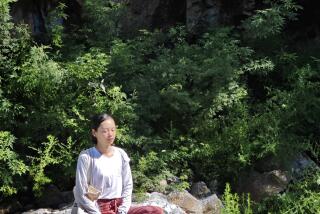China feels after-effects of economic stimulus
Housed in a five-story glass cube with a multiplex cinema and western brands like Gap and Sephora, the Care City Shopping Mall in southwest Beijing has all the ingredients for a great retail experience — except actual shoppers.
The visitors milling around on a recent muggy afternoon appeared most interested in the free air-conditioning and the food court. Salesclerks had little to do but nap, yawn or fiddle with their cellphones.
“It gets better on weekends,” said a hair-clip vendor flipping through a magazine.
Opened last year amid a nationwide construction frenzy, this sleepy mall may ultimately prove successful. But for now, the project shows why China won’t be spending big in the event of another global recession: It’s still paying for the last one.
To shield its economy from the fallout of the 2008 financial crisis, Beijing orchestrated a massive economic stimulus. It invested billions in infrastructure projects and encouraged banks to open the credit spigot to fund construction of apartments, office towers and retail centers.
The strategy catapulted China past Japan to become the world’s second-largest economy; its growth helped keep the global slump from deepening. China splurged on Australian iron ore, Chilean copper and Saudi Arabian oil to fuel its construction boom. While the U.S. economy was mired in recession, with negative year-over-year growth in gross domestic product in 2008 and 2009, China’s economy expanded by more than 9% annually over the same period.
But like taking steroids, there were side effects. The burst of credit has fueled inflation, which is proving painful for average Chinese. Soaring prices for pork, vegetables and other staples have authorities worried about the potential for social unrest. So has a property bubble that has put home ownership out of reach of millions, exacerbating the gulf between rich and poor.
Meanwhile, the nation’s debt levels have reached new heights. A national audit released in June found outstanding loans to local governments, among the biggest players in the building binge, amounted to $1.65 trillion, or nearly a third of China’s GDP.
There are also serious questions about how much new investment China needs. Although the construction blitz created millions of short-term jobs, there is slack demand for some of the resulting projects. Apartment towers in some cities are largely empty, as are malls and skyscrapers in others. China’s steel industry is saddled with so much extra capacity that it has been accused of dumping product overseas.
“If all this investment remains unprofitable for the long term, there will be serious risk to the banking system,” said Yi Xianrong, a researcher at the Chinese Academy of Social Sciences, a government think tank. “The problem is it’s become a tool for local government officials to compete and a hotbed for corruption.”
Faced with these risks, China has been trying to gradually cool its economy by hiking interest rates and tightening lending standards. Signs of a slowdown are already emerging in lower auto sales, factory closures and scuttled real estate deals.
But the big concern inside and outside of China is a so-called hard landing. If Europe and the U.S. fall back into recession and demand for Chinese-made goods declines, Beijing won’t be able to juice its economy like it did the last time around.
“It’s a lesson on the limits of stimulus. The more you do it, the less and less you’ll get out of it,” said Patrick Chovanec, a professor at Tsinghua University’s School of Economics and Management in Beijing. “You’ve already tapped all the good investments out there. A second time, you’d just be shoveling money out the door.... It will just compound their problems.”
The best solution for China, analysts said, is to turn its own citizens into shoppers whose buying power can drive the economy forward. Personal consumption accounts for about 40% of GDP in China, compared with about 70% in the U.S.
But closing that gap won’t be easy, given that China’s development model favors industry over consumers.
Beijing has deliberately kept the value of the country’s currency, the yuan, weak to keep its exports cheap and give Chinese factories an edge over foreign competitors. But a weak currency exacerbates inflation and erodes the buying power of Chinese households.
Consumption in China is growing — at a robust 8% a year. Crowds at Apple stores and Pizza Hut outlets in the country’s biggest cities point to pent-up demand. China’s newly minted millionaires are attracting luxury brands including Porsche and Cartier.
Yet China’s per capita annual income of $7,600 ranks below Angola and Albania. Although disposable income is rising, most households remain obsessed with saving because the social safety net is so flimsy. Individuals must shoulder most of the expense for their own healthcare, education and retirement.
A recent uptick in the value of the yuan against the dollar has some observers speculating that China is moving more aggressively to fight inflation and ease trade tensions with the West.
The country may be better able to weather any global recession when ordinary citizens such as Cheng Yaohua start opening their wallets at the Care City Shopping Mall instead of using it as a place to cool off on summer afternoons.
A migrant from central Henan province, Cheng earns $300 a month. He admired the styles on display in the window of the Gap store. But he shops in flea markets instead.
“The clothes over there cost a tenth of my monthly salary,” said Cheng, a 22-year-old cellphone salesman, nodding at the multi-story Gap. “After I paid for rent and food, I’d have nothing left if I bought something there.”
Nicole Liu and Tommy Yang in the Times’ Beijing bureau contributed to this report.
More to Read
Sign up for Essential California
The most important California stories and recommendations in your inbox every morning.
You may occasionally receive promotional content from the Los Angeles Times.










